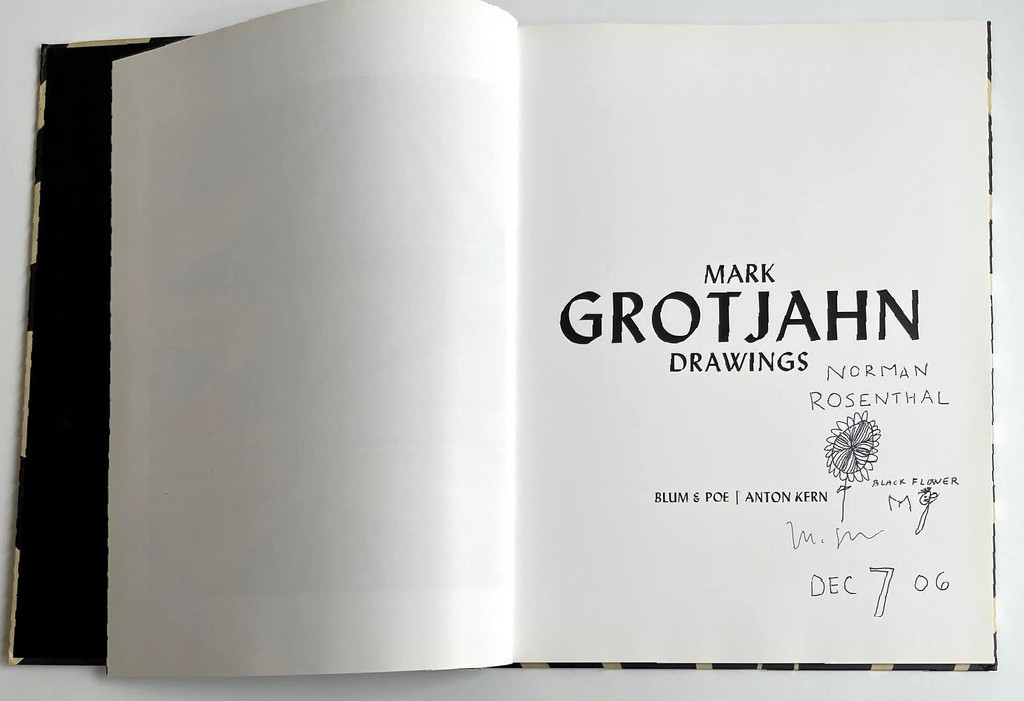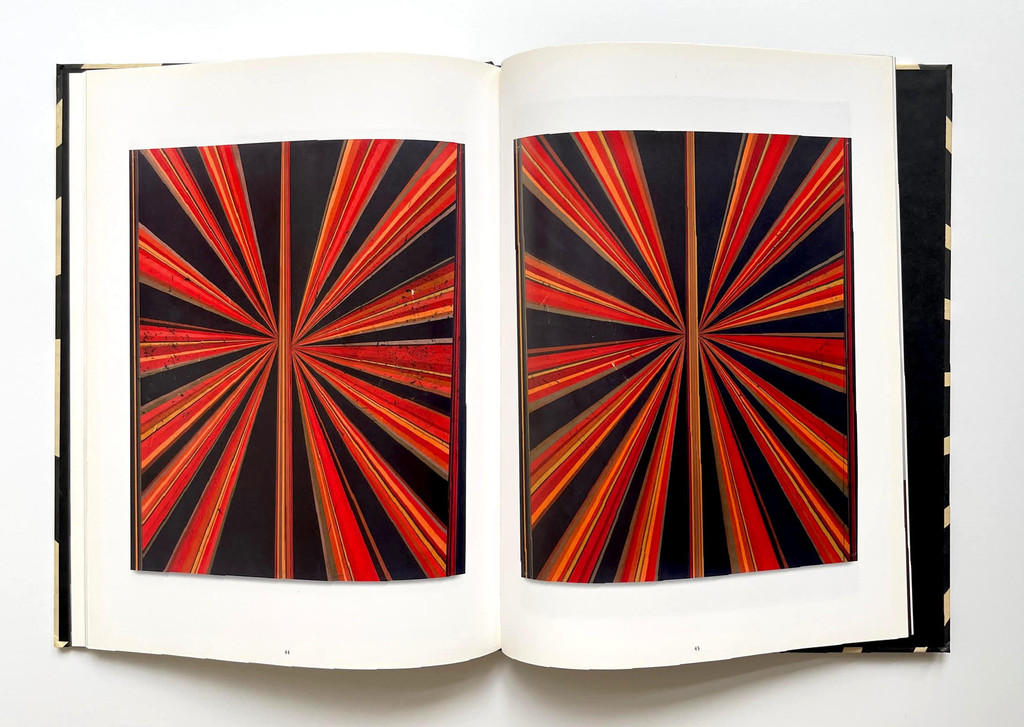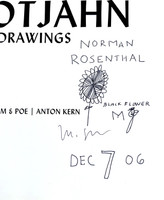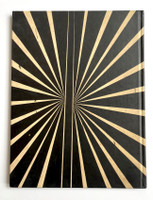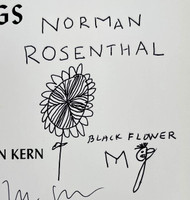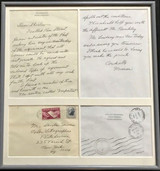
An Educated Collector is Our Best Client
In business for nearly two decades, we are a well established, popular contemporary art boutique specializing in expertly chosen, blue chip prints, multiples, uniques, books, ephemera and merchandise at different price points, with a focus on the secondary market. Please click on the "Contact Us" button at the bottom of this page for questions about any work, pricing and/or to arrange to visit our showroom/gallery - located in between Manhattan's Flatiron and Chelsea Flower Districts.
Mark Grotjahn, Black Flower (inscribed to art historian Norman Rosenthal), 2006
CONTACT GALLERY FOR PRICE
Description
Mark Grotjahn
Black Flower (inscribed to art historian Norman Rosenthal), 2006
Original flower drawing done in black marker, hand signed, titled and inscribed, held in hardback monograph
Hand signed, dated and inscribed with flower drawing by Mark Grotjahn on the title page
12 1/4 × 9 1/4 × 1/2 inches
This unique, original signed flower drawing is done on title page of a lavishly illustrated, 2006 hardback monograph published by Blum & Poe, with illustrated cloth boards and no dust jacket as issued.
The inscription reads:
Norman Rosenthal
[Flower Drawing] Black Flower MG
Dec 7 06
Biography of Norman Rosenthal (recipient of this drawing):
Norman Rosenthal (b.1944) is a London-based freelance curator. He first rose to prominence as the director and chief curator of the Royal Academy, a position he held between 1977 and 2008. During his tenure he worked towards assembling a variety of prodigious exhibitions, including Italian Art of the Twentieth Century (1989), the controversial Sensation: Young British Artists from the Saatchi Collection (1997), and the well-regarded Anish Kapoor retrospective of 2009. He left the Academy in 2008 to pursue a variety of self-directed projects.
In his early career Rosenthal worked at the Leicester Museum and Art Gallery before gaining valuable experience as an art researcher for London dealers and publishers Agnew and Sons. He then moved to the Brighton Museum and Art Gallery, coordinating shows as an exhibitions officer for four years before taking the position of curator at the Institute for Contemporary Art in London. His two years spent at the ICA from 1973 were of vital importance for his professional development and understanding of contemporary art.
Accorded a travel grant for his work as curator, he explored Germany, a nation rife with political tension after the student protests of 1968. It was during this journey that he met the Greek art historian and curator Christos Joachimides, who became a long-time friend and collaborator. He soon became affiliated with the avant-garde artists of the period such as Joseph Beuys, Hans Haacke, and Gustav Metzger. Having a German mother, Rosenthal spoke the language fluently, facilitating close relationships with these artists and more, including them in his first major exhibition at the Institute Art into Society; Society into Art. The show of radical German art, one of the first of its kind in London, was formed in collaboration with Joachimides.
After two years Rosenthal became displeased with the upper management of the ICA, leaving his post to begin writing for the Spectator. The current president at the time of the Royal Academy, Hugh Casson, took notice of an article criticising the institution for its lack of drive and direction. Casson forwarded it on to the Academicians, an act which in part led to Rosenthal’s hiring as exhibitions secretary. For over thirty years he oversaw events at the RA while securing numerous high-profile loans and collaborating with a plethora of revered curators. His work led to the revitalization of the museum, and the enablement of monumental exhibitions, ranging the gamut of Renaissance to contemporary art. While showcases on Frans Hals, Chardin, Goya, Mantegna and Sir Joshua Reynolds were well received, it was in contemporary art that Rosenthal would cement his status as a curator where he is most active today. Throughout his tenure at the Royal Academy he also curated exhibitions which traveled oversees, such as British Art in the Twentieth Century (1987) shown at the Staatsgalerie Stuttgart, and American Art in the Twentieth Century (1993 at the RA) which was exhibited at Martin-Gropius-Bau Berlin in 1994.
Since leaving the Royal Academy Norman Rosenthal has been involved in exhibitions with the Ashmolean Museum in Oxford, the Gagosian Gallery in New York, and the Galerie Thaddaeus Ropac in Paris.
Rosenthal has been bestowed with numerous awards in recognition of his services to art and culture, including the Iron Cross Order of Merit in 1991 (Germany), Officier, l’Ordre des Arts et des Lettres (France) in 2003 and the German British Forum Award in 2003. In 2007 he was awarded a knighthood in the Queen’s Birthday Honours List.
His versatility and unrelinquishing contribution to the contemporary art world has distinguished him as one of the foremost and celebrated curators of his generation.
Book information:
Published by Blum & Poe and Anton Kern Gallery on the occasion of the exhibition Mark Grotjahn held at Blum & Poe Los Angeles, September 8 - October 8, 2005. This catalogue features 62 lavish full color images of some of Mark Grotjahn's most well known works, including many from his famous butterfly series.
Physical description:
Hardcover, 63 pages
Los Angeles: Blum & Poe; New York: Anton Kern Gallery, 2006
About Mark Grotjahn:
Mark Grotjahn combines gesture and geometry with abstraction and figuration in visually dynamic paintings, sculptures, and works on paper. Each of his series reflects a range of art-historical influences and unfolds in almost obsessive permutations.
Grotjahn was born in Pasadena, California. He received a BFA from the University of Colorado at Boulder and an MFA from the University of California at Berkeley. While studying in California, he began his first major project, Sign Exchange (1993–98), in which he painted replicas of signs that he saw in stores around Los Angeles, then had the store owners display his hand-painted versions in place of the originals. In 1995 Grotjahn was an artist-in-residence at the Skowhegan School of Painting and Sculpture in Madison, Maine. He moved to Los Angeles a year later and, with his classmate Brent Petersen, opened the short-lived gallery Room 702.
In 2001 Grotjahn began the Butterfly series. These geometric paintings and drawings explore the constructs of dual and multi-point perspective and take on various forms as Grotjahn alters their composition and color. A selection of multicolored and monochromatic Butterfly works on paper were exhibited in 2005 at the Hammer Museum, Los Angeles. In 2018 the Los Angeles County Museum of Art presented 50 Kitchens (2013–18), from the same series, a work with more than fifty parts that all evolved from a single composition and incorporate residual traces of earlier drawings. Continuing his investigations of symmetry, perspective, and form, Grotjahn began the Face paintings in 2003. These expressive, anthropomorphic works of cardboard on canvas often feature sections cut away to reveal painted canvas beneath. As the series progresses, the faces become less apparent and more abstract, their curved lines creating void-like apertures.
Alongside his painting practice, Grotjahn has been making masks since 2000, painting cardboard boxes lying around his studio and affixing paper tubes between cut-out “eyes.” The Masks (2000–), although originally approached as a less formal project, came to assert themselves as a new armature for his painting. In 2010 Grotjahn started casting the Masks in bronze. In many of the sculptures, he incorporated and retained remnants of the bronze casting process, such as the sprues and runners, into his final work. As he does with his paintings, Grotjahn often boldly signs the Masks, allowing his signature to come forward as a compositional element. In 2014 the Nasher Sculpture Center in Dallas presented the first museum exhibition of Grotjahn’s sculpture, including small-scale and larger freestanding works.
In 2016 Grotjahn began the Capri works (2016–), seeking to break away from the Face paintings in favor of a more experimental, spontaneous working process. The first Capri works, New Capri, were modestly scaled paintings created for a private presentation at Casa Malaparte in Capri, Italy. Following this exhibition, Grotjahn created the Capri paintings (2016–), followed by the Free Capri series (2018–), in which he introduced the technique of scraping out areas of thick paint, then placing the resulting “slugs” in rows and grids elsewhere on the canvas.
As the Butterflies, Faces, Masks, and Capri series continue to expand, Grotjahn uses Instagram to further experiment with repetition and juxtaposition, employing the grid format to freely arrange images in different combinations, in a form of visual tic-tac-toe. Throughout his work, by finding variations within his immediately identifiable style, Grotjahn reveals the complexities of authorial gesture.
Courtesy to Gagosian Gallery





